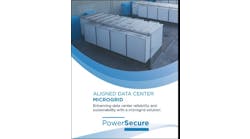Microgrid Resources Coalition Urges Regulators to Value Energy Service, Not Source
The Microgrid Resources Coalition (MRC) is urging regulators to focus on energy services, not sources, as they set tariffs and pricing for an increasingly distributed U.S. grid.
The advocacy organization is taking this message to the National Association of Regulatory Utility Commissioners (NARUC), as well as various states where fast-growing distributed energy is forcing a rethinking of conventional pricing structures.
Places with high solar use, like California and Hawaii, grapple with a changing electric grid that defies conventional supply and demand patterns. (See California duck curve.) States anticipate even greater transformation ahead, especially if microgrids and other forms of distributed energy grow as quickly as solar has. The change opens up questions about fair pricing for consumers, utilities and distributed energy providers.
In a recent interview, Baird Brown, counsel to MRC, explained how the organization wants to shape the understanding and treatment of microgrids in the regulatory arena. The approach also is summed up in comments that MRC filed in response to a draft manual on distributed energy resources prepared by NARUC.
The rate design manual is important because states often consider NARUC’s guidance before taking regulatory action. So not surprisingly, the draft manual has drawn a lot of attention, with comments filed by 72 parties since its July release. NARUC, a non-profit that represents public service commissions, plans to issue the final manual before its annual meeting November 13-16 in La Quinta, California.
MRC is encouraging NARUC to steer clear of recommending pricing approaches that value a particular energy source – such as energy storage. Instead, MRC calls for valuing the services those resources provide – such as ancilliary grid services or public good benefits like carbon dioxide reduction. All technologies would be paid the same rate for providing a particular service under the MRC model.
“Value, and charge for, and pay for services. Define the services and let everybody compete. Don’t try to regulate by classes of technology,” said Brown, a partner with Drinker Biddle & Reath.
For example, if an energy storage system and a combined heat and power plant each supply the grid with frequency response services, they should both be paid the same tariff for the service, he said. There should not be separate pricing for different forms of distributed energy.
Smart and dumb energy resources
Microgrids stand to fare well under a system that values services because they provide so many. Not all distributed energy resources have this ability. Some are smart; others dumb. A solar panel on a roof may be “uncommunicative and unresponsive,” Brown said. A microgrid is not.
Microgrids are “designed to turn on a dime,” he said, and provide quick services like rapid spinning reserve. “For the most part microgrids are quicker, faster, better than your average resource on the grid.”
In its comments filed with NARUC, MRC listed several microgrid services. Among them, microgrids can:
- Provide some combination of energy, capacity, ancillary or related services to the grid
- Offer demand response and energy management services, including management of variable renewable energy
- Capture efficiencies through co-management of electric and thermal loads
- Use electric and thermal storage to locally manage variable renewable generation
- Undertake smart management of thermal loads to use buildings as thermal storage to manage load shape
“These and similar efficiency and energy management strategies not only save money but also significantly reduce the environmental impact of providing energy services,” MRC said.
Advanced microgrids can provide more finely tuned services, beyond traditional demand response or ancillary services. For example, they can “moderate power prices and grid congestion by efficiently shifting load to times of lower demand and pricing and by locating generation closer to loads.In addition, microgrid customers typically make substantial investments in energy efficiency, MRC said.
“They adopt passive measures that reduce energy consumption, and more efficient HVAC and other systems that, when coupled with sophisticated controls, allow them to manage their load shape as well as further reduce load. These investments are made to operate in tandem with their generating and thermal generating systems,” MRC said.
How to define microgrids
Given these abilities, microgrids warrant a broader definition than the one in the NARUC draft manual, which described them as ‘localized grids that can disconnect from the traditional grid to operate independently and help mitigate grid disturbance,’ MRC said.
“While we agree with the definition to the extent that it describes a micro control area, the definition focuses entirely on the ability to island from the larger grid,” MRC wrote.
Despite all that they offer, advanced microgrids face strong barriers to entry, particularly “very limited compensation” for their grid services, according to MRC.
“Rate-making policies should account now for the growth of smart, responsive DERs [distributed energy resources] and their associated grid services rather than leaving the discussion for the future, or the future may never arrive,” the organization said. “A single rate class will never capture the diversity of DER and will improperly discriminate against microgrids.”
Track news about the Microgrid Resources Coalition by subscribing to the free Microgrid Knowledge newsletter.






